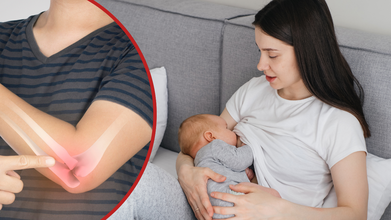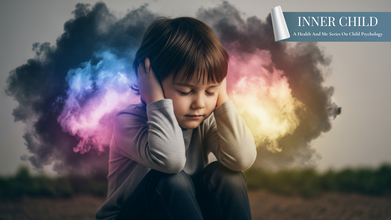- Health Conditions A-Z
- Health & Wellness
- Nutrition
- Fitness
- Health News
- Ayurveda
- Videos
- Medicine A-Z
- Parenting
- Web Stories
Strict Parents Raise Great Liars- The Parenting Mistake You Didn’t See Backfiring

Image Credits: Canva
While structure and rules are essential for a child's development, research suggests that excessive strictness can create unexpected effects—one among these is dishonesty. Research has shown that children of extremely strict parents are not just more likely to lie, but they also become very adept at it. The psychology behind strict parenting and its contribution to raising dishonest children is discussed in this article.
Kids are impressionable and learn behaviors from their environment, especially from their parents. When they grow up around strict and punitive parenting, they tend to develop lying as a coping mechanism to prevent severe punishment. Psychologists note that children imitate their parents' actions. If parents use deception often—even small white lies—children tend to learn dishonesty as the right thing to do when dealing with authority figures.
One of the classic instances of parental lies involves saying things like- "If you don't eat up your food, you will have pimples all over your face", "If you don't obey, I'll call the police", "We can't afford to buy that toy."
These kinds of words, though very harmless, demonstrate an environment where children experience that lying is a good strategy to control or escape situations rather than behaving honestly.
Victoria Talwar, a child development psychologist at McGill University, has done research that shows a high correlation between punitive parenting and higher deception in children. Her research was on children from two schools: one that was strict in its discipline and another that was lenient. The research tested the honesty of the children using a game-like experiment to see if they could resist looking at a toy when left alone in a room.
The children between 3-4 years old were asked to guess a toy by the sound it produced. In the last round, a misleading sound was used, and the children were left alone with the toy to check if they would peek. When the experimenter returned, the children were queried if they had peeked at the toy.
Results: 80% of all children peeked, but nearly all the children at the strict school lied about it.
Observation: Not only did these kids lie, but they went out of their way to cover up, showing a more sophisticated ability to sustain deception than their peers at the lenient school.
Conclusion: Children who grow up in environments of severe punishment are likely to be good liars to escape punishment. On the other hand, children who grow up in more understanding and communicative environments were likely to admit.
Why Do Strict Parents Raise Liars?
1. Fear of Punishment Over Honesty
Children are inclined to shun pain and discomfort. When they are punished strictly for not telling the truth, children learn that honesty has ill effects. Therefore, they learn dishonesty as a means of survival.
2. Lack of Emotional Safety
A home where children fear their parents' reactions is a home where honesty cannot thrive. When a child feels unsafe expressing their mistakes or concerns, they will resort to lying as a means of self-preservation.
3. Perceived Loss of Control
Too harsh a parenting style tends to take away the sense of autonomy in children. Children who feel that they have no control over their lives may use lying as a way of reasserting some control.
4. Role of Cognitive Development
Lying involves cognitive abilities like working memory and problem-solving. According to some research, children who lie proficiently are more intelligent. This does not imply that lying must be promoted but that parents must provide an environment where honesty pays and mistakes are seen as learning opportunities instead of offenses to be punished.
Long-Term Impact of Strict Parenting
Authoritarian parenting can appear to work in the short term, but it usually has undesirable psychological and behavioral consequences that last well into adulthood:
- Higher Anxiety and Depression: Constant fear of punishment can cause mental health problems, such as anxiety and depression.
- Rebellious Behavior: Children who are too overly controlled may act out in private, indulging in dangerous activities as a rebellion.
- Strained Parent-Child Relationship: No trust and effective communication can damage the emotional bond between the parent and the child.
- Poor Social Skills: Excessively controlled children often end up struggling with social interactions because they have had little practice at open self-expression.
How to Foster Honesty Without Strictness
- Provide a safe environment in which your child feels free to talk about his or her errors without fear of being punished. Rather than blaming them for making mistakes, show them how they can make better choices.
- Threats and harsh punishments result in children respecting authority less, not more. Use logical consequences that make them realize the effects of their behavior.
- Kids learn from their parents. If they see honesty and integrity in your behavior, they are more likely to do the same.
- Praise and reward your child when they tell the truth, even if it is a tough situation. Rewarding good behavior can reinforce honesty better than punishing bad behavior.
Parenting is not being too strict or too lenient—it is finding the right balance. Though rules and discipline are essential, they must not be enforced at the expense of honesty and emotional health. Establishing a setting in which children feel comfortable being honest will not only discourage lying but also create a more robust and healthier parent-child relationship. Ultimately, children who feel heard and respected are more likely to become honest, responsible adults.
Strong Babies, Weak Bones? Does Breastfeeding Actually Cause Women To Lose Bone Density?

(Credit-Canva)
Pregnancy changes a woman’s body in many different ways. Not only do women experiences changes in their hormonal balance, but they also find that things like pelvic pain urine leakage etc., may become permanent as well.
It is also not new information how a mother’s body prioritizes the health of the baby, over its own sustenance, however, does that mean this could cause the mother’s health to suffer permanently?
A few studies have suggested that women who breastfeed often lose their bone density, causing them issues like osteoporosis. Osteoporosis, a condition that makes bones weak and brittle, is a big health concern, especially for women after menopause. Doctors and researchers have long wondered if pregnancy and breastfeeding could play a role in this later in life.
The main idea is that during pregnancy and breastfeeding, a woman's body needs a lot of calcium for the baby. This high demand, along with low estrogen levels, might affect the mother's bone health.
Does Breastmilk Draw Nutrient From Women’s Bones?
According to National Institute of Arthritis And Musculoskeletal And Skin Diseases during both pregnancy and breastfeeding, a mother's body needs a lot of calcium to help her baby grow. Some of this calcium comes from the mother's bones, which naturally causes a temporary decrease in her bone density. This is a normal part of pregnancy and breastfeeding and usually happens most during the third trimester and while she is nursing.
While a temporary decrease in bone density is normal during pregnancy and breastfeeding, your bone density usually returns to normal after you give birth and during or after you stop breastfeeding.
However, in very rare cases, some pregnant or nursing women might develop osteoporosis. This can lead to fractures, especially in the spine, that can happen without much stress or injury.
Does Breastfeeding Increase Risk of Osteoporosis?
Many studies have looked into this issue, but there is still no clear answer. Some research suggests a link, while other studies don't. Because there's no agreement among experts, a 2024 study was done to get a better understanding. Researchers reviewed all the available information on osteoporosis, pregnancy, and breastfeeding to see what the facts currently show.
However, what researchers found was much different than they anticipated. Researchers at UC San Francisco and UC Davis solved the mystery of how breastfeeding women's bones stay strong even when calcium is taken from them to make milk. They discovered a new hormone called Maternal Brain Hormone (MBH), also known as CCN3, that makes bones stronger and denser. This finding, published in Nature, could one day help people with broken bones and diseases like osteoporosis.
Could This Research Lead To Better Bone Health Care?
The researchers found that when they gave MBH to young and old mice, both male and female, their bones became much stronger. In some very old female mice that had no estrogen (which normally helps build bones), the hormone was able to more than double their bone mass.
To see if MBH could help with healing, the scientists created a special gel patch that slowly released the hormone onto a broken bone. In older mice, whose bones normally don't heal well, the patch helped new bone form and heal the fracture. This successful outcome has never been seen before with other treatments. The researchers are excited about the potential of MBH to help people with various bone conditions, including:
- Women after menopause who are at high risk for osteoporosis, a disease that causes bones to become weak and break easily.
- Breast cancer survivors who lose bone mass from their treatment.
- Elite female athletes.
- Older men who have suffered a hip fracture.
How Much Calcium Do Women Need?
The amount of calcium a woman needs each day doesn't change when she is pregnant or breastfeeding.
Ages 14-18: 1,300 mg per day.
Ages 19 and older: 1,000 mg per day.
Getting more calcium than these recommended amounts from food or supplements won't stop the temporary bone loss that happens during this time. For this reason, extra calcium doesn't have a big impact on how much bone a woman loses. If you're pregnant or nursing and are thinking about taking a calcium supplement, you should always talk to your doctor first.
Inner Child: Sensitive Kids Aren’t “Too Emotional,” They Just Experience Feelings Differently

Credits: Health and me
Inner Child’ is Health and Me's new mental health series where we deep dive into lesser-known aspects of child psychology and how it shapes you as you grow up. Often unheard, mistaken, and misunderstood, in this series we talk about the children’s perspective and their mental health, something different than you might have read in your parenting books. After all, parenting is not just about teaching but also unlearning.
Teachers and parents have, for many years, branded some children as "too emotional" or "too sensitive." Behind these words, there is usually a good intention hiding a misunderstanding these children are not broken or overreacting. They have nervous systems that are designed to feel more deeply, more intensely and more tenaciously than other children.
What this actually is, is that sensitivity in children is not as much about weakness as it is about difference. Grasping that difference is important to creating emotionally healthy, resilient, and confident kids.
Why Sensitivity Isn't a Flaw?
High sensitivity is an old phenomenon. Psychologist Dr. Elaine Aron originally described the "Highly Sensitive Person" (HSP) in the 1990s, explaining that about 15–20% of the population is more sensitive to sensory input, feelings, and surroundings. Kids who meet this criterion view the world with a intensity that at times overwhelms them—but it also provides them with special strengths.
Sensitive children sense subtleties that most others do not. They can sense the tension in a room before anyone says a word, catch the smallest change in a friend's mood, or be deeply touched by music, art, or literature. The catch is that they also take on more stress, criticism, and conflict, causing adults to write them off as dramatic or breakable.
But studies indicate that this more intensive processing is not a deficiency. Instead, sensitive children tend to exhibit greater empathy, creativity, and sensitivity. Their ability to "feel big" is a double-edged sword: painful at times, but equally beautifully enriching.
Neurological research indicates that sensitive children might have variations in brain response patterns. Functional MRI scans of extremely sensitive individuals demonstrate more activation of areas associated with awareness, empathy, and emotional control.
Simply put, when most children experience sadness, happiness, or fright, the emotional reaction goes away fairly quickly. Sensitive children, on the other hand, experience the same emotion through several layers—cognitive, sensory, and empathetic. This means it's a longer, more powerful emotional experience.
Parents tend to misunderstand this as exaggeration. What's actually occurring is not an exaggeration—it's amplification. Their internal world is cranked up a few degrees, so the same emotional incident registers differently.
How Sensitivity Appears in Childhood?
All children show sensitivity in their unique way, but there are some common patterns that psychologists and pediatricians observe in highly sensitive children:
Deep emotional responses: Crying, laughter, or irritation that appear out of proportion to the context.
Profund empathy: Consoling friends, fretting about others, or even getting distressed at news reports or animal cruelty.
Overwhelmed in bustling settings: Busy classrooms, loud birthday parties, or disruption to routine can cause meltdowns.
Perfectionism and self-criticism: Sensitive children can be perfectionists, setting high expectations for themselves and crushing themselves when they fail.
Rich inner lives: They usually adore telling stories, daydreaming, or role-playing, channelling feelings through creative expression.
What adults perceive as "too much" is actually a system that has yet to master regulating or expressing its depth.
What Is The Cost of Mislabeling Sensitive Kids?
When adults dismiss a child’s emotions with phrases like “Don’t be so dramatic” or “You’re too sensitive,” they unintentionally send a message: your feelings aren’t valid. Over time, this can teach children to suppress or distrust their emotions, leading to anxiety, self-doubt, or difficulties in relationships.
Worse still, some kids start to internalize shame. They may think there's something wrong with them because they care too much, cry a lot, or require more recovery time after stressful situations.
Psychologists caution that this criticism of themselves can extend into adulthood, manifesting as people-pleasing behaviors, burnout, or difficulty setting boundaries.
Reframing Sensitivity as Strength
The major turn is to redefine sensitivity as an asset--not a shortcoming. Research indicates that sensitive children who are raised in nurturing environments end up flourishing more than their less-sensitive counterparts. They do exceptionally well in empathy-related professions, are highly creative, and tend to have excellent emotional intelligence.
This is known as differential susceptibility: sensitive children are more influenced by their environments, both good and bad. That means that criticism can cut them deeply, but praise and understanding can enable them to blossom way above the norm.
How Parents Can Support a Sensitive Child?
Raising or teaching a sensitive child needs patience and redefining expectations. Some things supported by developmental psychology are:
1. Validate, Don't Dismiss
Instead of telling a child they’re overreacting, acknowledge what they’re feeling: “I see you’re really upset. Let’s take a moment together.” This doesn’t mean indulging every emotional swing, but showing their emotions have value.
2. Teach Emotional Regulation
Sensitive kids need tools to navigate their depth. Breathing exercises, mindfulness, journaling, or even physical activity can help them move through overwhelming feelings in healthier ways.
3. Create Safe Recovery Spaces
Quiet time following school, reading nooks, or soothing bedtime rituals provide sensitive children with a space to unwind from overstimulation.
4. Support Their Strengths
Emphasizing creativity, empathy, or critical thinking helps sensitive children realize their sensitivity is an asset rather than a weakness.
5. Model Healthy Emotional Expression
Kids learn from what they see. Parents who express their own emotions openly and calmly are teaching children that feeling deeply is ordinary and navigable.
How a sensitive child is treated during early years determines their adult life fundamentally. Those who are nourished end up being empathetic leaders, artists, caregivers, or innovators. Those who are shamed end up being adults with anxiety, depression, or identity issues.
Therapists working with highly sensitive adults often trace the roots of their struggles back to childhood experiences where emotions were invalidated. The “inner child” work many undergo in therapy is essentially about reconnecting with that sensitive child, acknowledging their feelings, and offering the validation they never received.
Calling sensitive children "too emotional" isn't just missing the point—it can do lasting damage. It's an era when mental health issues are increasingly on the rise globally, and recognizing the complexity of emotions is more necessary than ever.
Rather than trying to teach children to toughen up, we need to teach them to find their way through their emotional worlds with confidence. Sensitivity is not something to be fixed it's a kind of intelligence to be cultivated.
Each child feels emotions differently, but for highly sensitive children, they feel them in high definition. They don't need to be "fixed"; they need to be guided, supported, and validated. When we shift away from belittling them as "too emotional" and towards valuing their depth, we open the door for them to become compassionate, innovative, and resilient adults.
Parents, Have You Given Your 12-Year-Old A Smartphone? Global Study Links Early Use To Serious Mental Health Risks

Credits: Canva
A smartphone in the hands of a child might look harmless—useful, even. It offers parents peace of mind, connects children with friends, and provides access to learning tools. But new research suggests that early smartphone ownership could carry a hidden cost that lasts well into adulthood.
A global study involving more than 100,000 participants has found that young adults who first received a smartphone before age 13 report significantly worse mental health, including higher rates of suicidal thoughts, aggression, detachment from reality, and low self-worth. The findings, published in the Journal of Human Development and Capabilities, point to a troubling association: the younger a child is when they first own a smartphone, the greater their risk of long-term emotional and psychological struggles.
The research, led by Sapien Labs through its Global Mind Project—the world’s largest mental wellbeing database—focused on individuals aged 18 to 24. Those who had smartphones at 12 or younger consistently scored lower on the Mind Health Quotient (MHQ), a tool that measures social, emotional, and cognitive wellbeing.
Young adults who received their first smartphone at 13 averaged an MHQ score of 30.
Those who had one by age five averaged just 1—a near collapse in mental wellbeing indicators.
Symptoms tied most strongly to early smartphone ownership included suicidal thoughts, increased aggression, detachment from reality, and hallucinations.
The analysis showed the effects were consistent across cultures, languages, and regions, underscoring what researchers describe as a “critical window of vulnerability” during childhood development.
Why Early Smartphone Use Affects Mental Health?
Smartphones are not simply phones—they are portals into social media, gaming, and AI-driven feeds that shape how children perceive themselves and the world. Dr. Tara Thiagarajan, neuroscientist and lead author of the study, explains:
“Our data indicate that early smartphone ownership—and the social media access it often brings—is linked with a profound shift in mind health and wellbeing in early adulthood.”
Children under 13 appear to be particularly vulnerable to cyberbullying, poor sleep quality, and weakened family relationships, all of which can accumulate into mental health symptoms later in life. The study estimates that early access to social media accounts for about 40% of the association between smartphone ownership and adult mind health, with disrupted sleep and family strain contributing significantly as well.
How Screentime Is Impacting Kids Mental Health?
Traditional studies on screen time often focus narrowly on depression and anxiety. What makes this research stand out is its broader scope. Symptoms like aggression, detachment from reality, and suicidal ideation are not always captured in conventional mental health assessments. Yet these outcomes, according to the study, are rising sharply among younger generations and carry serious societal implications.
For instance, the proportion of young women classified as “distressed or struggling” rose by 9.5% when they received a smartphone before age 13. For men, the increase was 7%. While females often reported lower self-image and emotional resilience, males showed diminished calmness, empathy, and stability.
Are Smartphones Are A Boon Or Bane?
Since the early 2000s, smartphones have reshaped how young people learn, communicate, and build identity. Yet the same technology that holds out hope of connectivity also generates comparison, isolation, and access to toxic content. The recommendation algorithms that utilize AI technologies accelerate these dynamics, keeping kids trapped in scrolling loops that tend to replace sleep, face-to-face engagement, and family time.
While most social media sites limit accounts to people 13 and up, regulation is lax. As such, children as young as eight frequently set up accounts and partake in content intended for much older viewers.
Governments are starting to act. France, Italy, the Netherlands, and New Zealand have placed limits on the use of phones within schools. In the United States, states such as New York, Alabama, and Arkansas have enacted or proposed similar measures. Initial statistics from the Netherlands indicate these interventions enhance concentration in class, but the long-term mental health effects are uncertain.
Though the study doesn't establish causation, it can't conclusively state that smartphones lead to mental health downturns—it shows a robust and consistent relationship in various populations. Researchers note that other factors, including the COVID-19 pandemic, might have amplified these trends. Nevertheless, the size of the issue, impacting millions of young adults globally, is too large to overlook.
The argument about teen smartphone use is not merely about personal health, it's about the health of societies as a whole. Increasing levels of suicidal ideation, violence, and disconnection among young people have ripple effects, from compromised healthcare systems to reduced workforce productivity and eroded community ties.
By comparing the situation to existing restrictions on alcohol and tobacco, scholars contend that societies already possess blueprints for protecting children from dangerous substances and settings. The problem is finding the political will and interagency cooperation to apply those protections to the online world.
© 2024 Bennett, Coleman & Company Limited

